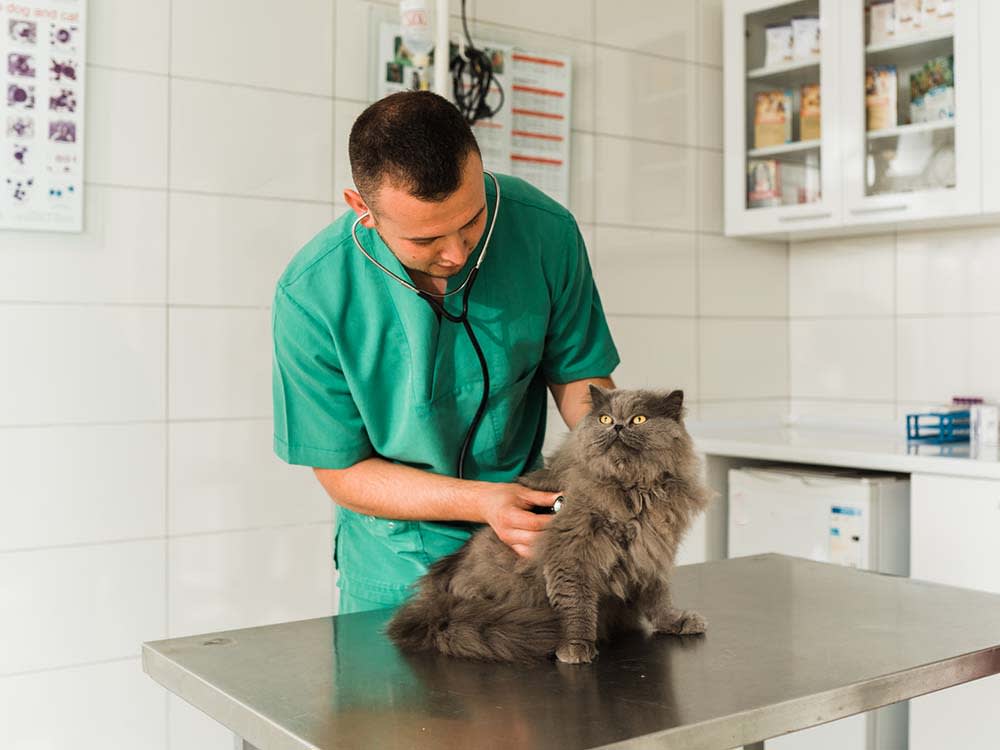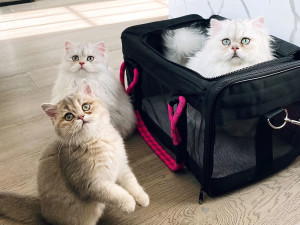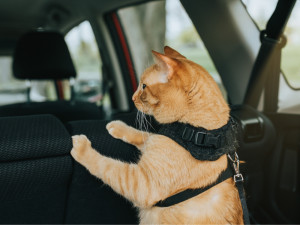How to Make Vet Visits Less Scary For Cats
Two vets share their tips, from choosing a safe carrier to considering anti-anxiety medication.
Let’s face it, taking your cat to the vet is no walk in the park, which, coincidentally, may be an even harder task to accomplish with a cat in tow. There’s anxiety, fear of the unknown, and moments of pure chaos — plus, your cat is stressed, too. While there’s no one-size-fits-all way to ensure your cat feels cool, calm, and collected from the time they enter their carrier to when they touch down on that steely cold medical table, there are a few tips that can help most cats and their owners feel their best when preparing for a visit the vet. We asked Dr. Tammy Hunter, DVM, and Dr. Cheryl Yuill, DVM, to determine the best ways to turn an otherwise traumatic experience into just another day with your cat.
Why does my cat get stressed when we go to the vet?
Dr. Hunter: Cats are very territorial and attached to their home environments. Most pet cats live a sheltered life with a very predictable routine that does not involve traveling away from home, making a visit to the veterinarian an overwhelming experience. The cat is taken out of their home, usually roughly pushed into a carrier, put into a noisy car, driven to the veterinary clinic, where there are intense smells from many other pets and people. They are then taken into an examination room where an unfamiliar person administers various treatments. Any one of these things can be stressful, and when they are all combined together, it’s no wonder that your cat is frightened or stressed.
Should I use a cat carrier to take my cat to the vet?
Dr. Hunter: Veterinarians recommend the use of a carrier for travel because it is the safest and most secure way to transport animals. Once you arrive at the vet’s office, your cat will be safe from being bothered by other curious pets and will feel less vulnerable. A cat that is being held in your arms and becomes frightened may respond by trying to escape, potentially injuring you in the process, and putting your cat at risk for injury or loss.
What should I look for in a safe cat carrier?
Dr. Hunter: Individual cats may have specific preferences for a carrier, but some options are better than others. Although cardboard cat carriers (available from pet stores and animal shelters) are inexpensive and disposable, they should only be used as a temporary form of transport because a determined cat can break out of them in no time. Durable options for transporting your cat range from soft-sided carriers to wire crates to hard plastic carriers with wire doors.
How much do you spend on your pet per year?
The most important criteria for a carrier: It should be easy to clean and you should be able to get your cat in and out of it without a struggle. Purchase a carrier that fits your cat’s size and if you have several cats, provide each one of them with their own carrier. The ideal carrier is strong, lightweight, and waterproof, with a large opening to allow easy access to the cat, and an easy to remove top with ‘quick release’ fasteners. If you have a carrier with a removable top, your cat may be able to remain nestled in the bottom of the carrier while your veterinarian performs some parts of the routine physical examination. And if your cat needs to stay in the hospital for any reason, the bottom part of the carrier can be put into the hospital cage to provide a familiar and comforting bed.
If you opt for a carrier without built-in bedding, you should put a towel or blanket in the bottom, both to provide a comfortable place to sit or lie down, and to soak up any fluids in case your cat has an accident on the way to the clinic. It may be wise to take along a spare blanket and a plastic bag for any soiled bedding, just in case.
How do I get my cat into their carrier without a struggle (from either party)?
Dr. Yuill: Unlike dogs, who often associate car trips with fun destinations such as the park or trail, few cats go in the car for a pleasant adventure. For most cats, the only time they ever see their carrier is when it is brought out immediately before going to the vet, causing that carrier to be associated with the car ride and the unfamiliar sounds and smells of the average veterinary office. It is these stress-inducing associations that cause cats to resist getting into the carrier.
You can help your cat get over the fear of a carrier by developing positive associations with the carrier. The first thing to do is to avoid storing the carrier in the garage or basement and only bringing it out when a trip to the veterinarian is imminent. Instead, open the door or remove the top and keep the carrier out in an area where your cat likes to sleep or play. Set it up as your cat’s own private sleeping quarters or private dining room by placing their bed, food, and water dishes in the carrier. Or simply use the carrier as the spot where they get treats. This way, the cat can begin to associate it with the familiar sights and scents of home.
Another way to prepare for your visit to the vet is to spritz the carrier with three to four squirts of Feliwayopens in new tab ®, a synthetic copy of the cat’s facial pheromone, which may help create a sense of familiarity or security in the cat’s environment. If you do not have time to develop these positive associations before your next scheduled veterinary visit, make the carrier smell familiar to assure your cat that it is a safe haven by placing a blanket, towel, or even an old item of your clothing into the carrier. If your cat already has negative associations with the current carrier that you are using, consider purchasing a new carrier that does not resemble the old one.
How do I make my cat more comfortable with car rides to the vet?
Dr. Yuill: The most important consideration when transporting your cat is ensuring you have a secure carrier that will prevent any possibility of escape. It should be placed within the vehicle in a position that holds it securely in place in case you have to brake suddenly. Never drive with your cat loose in the car.
To reduce the stress of the car ride, you can spray your car interior with a couple of squirts of Feliway® 30 minutes to one hour before leaving. Bring a blanket or large towel with you, and once your cat is secured in the carrier in the car, cover the carrier with the towel to reduce visual stimulation. Once you start driving, turn the radio to a soothing station and make sure the heater or air conditioner does not blow directly into the carrier.
You can also teach your cat to relax in the car by taking short trips that have a positive outcome. For example, put your cat in the carrier, give them one of their favorite treats or toys, and take a short drive that ends up back home. During the entire process, speak to them in a calm and reassuring voice.
Can I give my cat a sedative or anti-anxiety medication?
Dr. Yuill: If your cat’s stress or fear is persistent, and they have no health concerns, your veterinarian may recommend giving some sort of prescription medication before the visit. However, most sedatives have side effects, and using them may not be in the best interests of your cat. While natural products are often thought of as benign, this is not always the case, particularly when it comes to treating cats, who have different metabolic processes than we do. Please speak to your veterinarian for more information about specific medications for your cat.
What should I do when I arrive at the vet?
Dr. Hunter: Ideally, schedule your appointment for a quieter time of the day. If your cat is suffering from high anxiety, you may want to check in with the staff on your arrival to see if you can bring the cat directly into an examination room rather than waiting in the reception area. Once you are in the examination room, ask your veterinarian if you can put the cat’s blanket on the examination table to bring them some familiarity. You can also suggest taking the lid off the carrier so that your cat can stay in it during part of the examination, as mentioned earlier.
Any other tips to lower my cat’s stress levels during a vet visit?
Dr. Yuill: Unless otherwise directed by your veterinarian, do not feed your cat for several hours before their appointment to reduce the chance of vomiting or having an accident during the trip. For some cats, a Thundershirtopens in new tab ®, which swaddles the cat much like swaddling an infant, may reduce anxiety. Finally, one of the most effective ways to decrease your cat’s anxiety level is to remain calm and relaxed during the visit. Speak to your cat in a soothing voice and reassure them by petting them in their favorite spot.
Source: VCAopens in new tab





